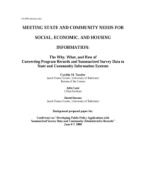
An official website of the United States government
Here’s how you know
Official websites use .gov
A .gov website belongs to an official government organization in the United States.
Secure .gov websites use HTTPS
A lock (
) or https:// means you’ve safely connected to the .gov website. Share sensitive information only on official, secure websites.
-
//
- Census.gov /
- Library /
- Census Working Papers /
- Converting Program Records & Survey Data to Information Systems
The Why, What, and How of Converting Program Records and Summarized Survey Data to State and Community Information Systems
The Why, What, and How of Converting Program Records and Summarized Survey Data to State and Community Information Systems
Abstract
This paper addresses the why, what, and how of creating modern state and community information systems, that is, multiple data sets that are geographically based, to better inform those who make decisions about program effectiveness and direction. Some states and communities have developed their Management Information Systems (MIS) for secondary use as a longitudinal data base for statistical analyses of the overall characteristics of groups of clients, the effects of client groups on other public services, and to evaluate the effectiveness (performance) of program policies. A new information resource profiles the population and housing of communities. That is the American Community Survey. It is a new survey the Census Bureau is developing to provide demographic, social, economic, and housing profiles of areas every year, eventually down to the neighborhood level.
The dynamic picture multiple information sources provide can help communities better understand the interactions between changes in a community’s population and other factors such as its industrial mix, economic development potential, health profile, and physical environment. With multiple sources of information, communities can move beyond program administration and performance measures to strategic decisionmaking. Communication of research results to those who make decisions about community policies can improve through new technology such as the layered mapping of Geographic Information Systems (GIS).
This paper describes administrative records as a source for statistical analyses, the new American Community Survey, and other information sources that describe a community’s situation compared with other areas. Using current information about population and housing trends from the American Community Survey, we illustrate how administrative records could be merged in econometric models with these summarized survey data to provide improved estimates and probability statements of events. This system protects individual privacy by using data sets matched to small geographic levels rather than individual people. There are other useful additions to econometric models such as the Economic Censuses to describe the economic conditions of metropolitan areas and regions. We address data quality issues in the various data sets and what needs to be done to convert program records to files that are useful for statistical analyses of communities.
Others in Series
Working Paper
Working Paper
Working Paper
Share
Some content on this site is available in several different electronic formats. Some of the files may require a plug-in or additional software to view.
 Yes
Yes
 No
NoComments or suggestions?


Top

